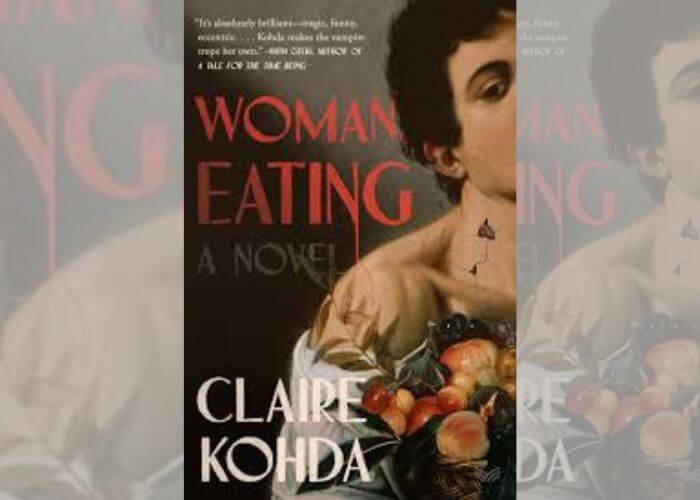Blog
Woman, Eating by Claire Kohda – Book Review

Introduction
In a world saturated with traditional vampire narratives, Claire Kohda’s stunning debut novel offers a refreshingly unique premise. Woman, Eating introduces readers to Lydia, a mixed-race vampire who must find a way to navigate the complexities of modern existence while balancing her supernatural nature with her desire for human connection. This debut novel marks Claire Kohda as a promising voice in contemporary literature, crafting an artful vampire novel that transcends typical genre boundaries.
Claire Kohda’s approach to vampirism serves as a powerful metaphor for exploring themes of identity, hunger, and the universal human struggle to find a place in the world. Unlike the romanticized vampires of popular culture, Lydia represents something far more relatable and deeply human despite her supernatural heritage.
Plot Summary (Spoiler-Free)
Lydia is a young vampire and recent art school graduate living in a cramped London studio space. Born to a Japanese father and a vampire mother, she embodies the challenges of mixed ethnic heritage while grappling with the additional complexity of her supernatural nature. Lydia is hungry – not just for blood, but for connection, purpose, and a sense of belonging in a world where she feels perpetually displaced.
Living away from her vampire mother for the first time, Lydia finds herself secretly squatting in an art studio with other young artists. She interns at a gallery where she observes the people at the gallery and struggles with her identity as both artist and predator. The young woman watches videos of people eating food on YouTube and Instagram, fascinated by many of the things humans take for granted, particularly the simple act of consuming human food.
While Lydia can’t eat traditional food, she remembers the food her Japanese father liked to eat, including sashimi and onigiri with sour plum stuffed inside. These memories serve as painful reminders of her connection to humanity and the life she can never fully embrace.
Major Themes Analysis
Identity and Self-Discovery
Kohda masterfully uses Lydia’s mixed-race vampire identity to explore broader themes of belonging and self-acceptance. The protagonist finds herself caught between two worlds – neither fully human nor fully vampire. This duality reflects the experience of many individuals with mixed ethnic heritage who struggle to find their place within rigid cultural categories.
The particular vampire that Lydia represents breaks away from the typical vampire trope. Instead of focusing on supernatural powers or romantic entanglements reminiscent of Buffy the Vampire Slayer, Kohda creates a literary vampire who grapples with ordinary concerns like paying rent, maintaining friendships, and finding meaningful work.
Hunger as Metaphor
The central metaphor of hunger extends far beyond Lydia’s need for blood. Kohda examines cravings of all kinds – for connection, for purpose, for acceptance. Lydia knows that while she can only digest blood, she hungers for the normalcy of sharing meals and the social bonds that form around food.
Her fascination with people eating food on YouTube reveals a deeper longing to participate in one of humanity’s most fundamental social rituals. The unusual young woman watches others consume bubble tea and other treats, experiencing a vicarious pleasure that highlights her isolation from human experience.
Mental Health and Isolation
Through its supernatural lens, the vampire novel addresses contemporary issues of mental health and urban loneliness. Lydia’s situation mirrors that of many young artists struggling to exist in the world while dealing with depression, anxiety, and the challenges of early adulthood.
The modern-day vampire serves as a metaphor for those who feel fundamentally different or disconnected from society. Lydia must navigate relationships with the artists at the studio space while concealing her true nature, reflecting the exhausting performance many people maintain to appear “normal” in social situations.
Writing Style and Structure
Claire Kohda’s prose demonstrates remarkable lightness of touch for such weighty themes. The first-person narrative creates intimacy between the reader and the protagonist, allowing us to experience Lydia’s internal conflicts firsthand. The literary vampire novel succeeds because Kohda never loses sight of the human elements within the supernatural framework.
The author skillfully weaves together contemporary London settings with the timeless nature of vampire mythology. Kohda’s background as someone who reviews books for publications is evident in her careful attention to language and structure throughout this enjoyable debut novel.
Strengths of the Novel
Woman, Eating succeeds as both speculative fiction and literary fiction. Kohda creates a vampire who feels genuinely contemporary, dealing with issues like sourcing fresh pig’s blood while maintaining her humanity and artistic ambitions. The vampire book avoids many pitfalls of the genre by focusing on character development rather than supernatural spectacle.
The representation of mixed ethnic heritage adds authenticity and depth to Lydia’s character. Kohda’s exploration of Japanese culture through food memories and family relationships provides a rich cultural backdrop that enhances rather than overshadows the supernatural elements.
Areas for Consideration
While this stunning debut novel has many strengths, some readers might find certain pacing issues in the middle sections. The balance between Lydia’s everyday struggles and her supernatural nature occasionally feels uneven, though this may be intentional to reflect the protagonist’s internal conflicts.
The resolution of Lydia’s central conflicts within her demon and human sides could benefit from additional development. However, this may reflect the realistic nature of identity struggles, which rarely have neat conclusions.
Comparisons and Context
Woman, Eating stands apart from other contemporary vampire fiction through its focus on identity and belonging rather than romance or action. While readers familiar with works like Buffy the Vampire Slayer might expect certain vampire tropes, Kohda subverts these expectations to create something genuinely original.
The novel joins a growing body of literature by debut authors exploring themes of cultural identity and belonging. Kohda’s work resonates with other books that examine the experience of being caught between two worlds, whether cultural, generational, or supernatural.
Final Assessment
Rating: 4.5/5 Stars
Woman, Eating represents an impressive debut from Claire Kohda. The vampire novel succeeds because it never forgets the humanity at its core. Lydia emerges as a fully realized character whose struggles with identity, hunger, and belonging will resonate with readers regardless of their familiarity with supernatural fiction.
This literary vampire novel is perfect for readers who enjoy character-driven narratives with supernatural elements. Fans of contemporary fiction exploring themes of identity and belonging will find much to appreciate in Kohda’s thoughtful approach to familiar vampire mythology.
Conclusion
Claire Kohda’s Woman, Eating proves that there are still fresh stories to tell within familiar genres. By creating a mixed-race vampire who must reconcile the conflicts within her nature while trying to balance her deep-seated desire to live amongst humans with her incessant hunger, Kohda has crafted a novel that speaks to universal themes of identity and belonging.
Lydia’s journey to find a way to exist in the world while maintaining her humanity offers hope to anyone who has ever felt like an outsider. This stunning debut novel establishes Claire Kohda as a writer to watch, and readers will eagerly await her future work.
The vampire may be a creature of the night, but Kohda’s debut shines brightly in the landscape of contemporary literature. Woman, Eating is a remarkable achievement that redefines what a vampire book can be in 2022 and beyond.
